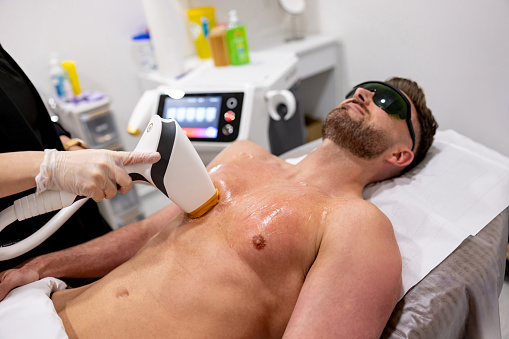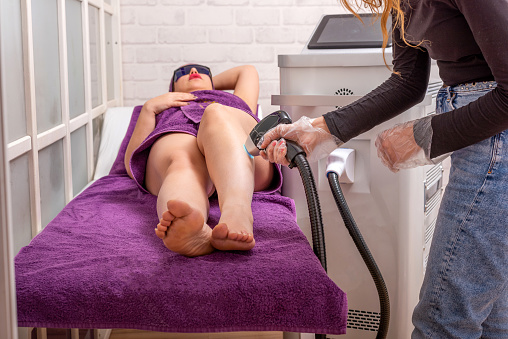The number of treatments required for laser hair removal can vary depending on several factors, including the individual’s hair type, skin color, and the area being treated. On average, most people will need a series of 6 to 8 treatments spaced several weeks apart to achieve optimal results.
Laser hair removal works by targeting the hair follicles during their active growth phase. However, not all hair follicles are in the same phase at any given time. Multiple sessions are necessary to target the hair follicles in their active growth phase during each treatment.

It’s important to note that individual results may vary, and some people may require additional treatments to achieve their desired outcome. It’s best to consult with a qualified professional who can assess your specific needs and provide a personalized treatment plan based on your hair and skin type
How many laser treatments does it take to permanently remove hair?
UNDERSTANDING LASER HAIR REMOVAL
Here’s a step-by-step overview of the laser hair removal process:
- Consultation: Before undergoing laser hair removal, it’s essential to have a consultation with a trained professional. They will assess your skin and hair type, discuss your medical history, and determine if you are a suitable candidate for the procedure.
- Preparation: Prior to the treatment, you may be advised to avoid sun exposure, tanning beds, and certain hair removal methods such as plucking or waxing. Shaving the treatment area a day or two before the procedure is usually recommended.
- Procedure: During the treatment, you will wear protective eyewear, and a handheld laser device will be used by the technician or dermatologist. The laser emits a controlled beam of light that is directed at the targeted area. The laser energy is absorbed by the hair follicles, damaging them while minimizing potential damage to the surrounding skin.
- Sensations: You may feel a sensation of heat or a mild pinprick during the procedure. Some individuals describe it as slightly uncomfortable, but most find it tolerable. The technician may apply a cooling gel or use a cooling device to help alleviate any discomfort.
- Multiple sessions: Since hair grows in cycles, multiple treatment sessions are required to effectively target hair follicles in different growth phases. These sessions are typically spaced several weeks apart, allowing time for new hair to enter the growth phase.
- Post-treatment care: After the procedure, you may experience temporary redness, swelling, or mild discomfort in the treated area. Applying ice packs or soothing creams can help alleviate any discomfort. It’s crucial to follow the post-treatment care instructions provided by your practitioner, which may include avoiding sun exposure and using sunscreen.
- Results and maintenance: Laser hair removal provides long-term hair reduction. After completing the recommended sessions, you can expect a significant reduction in hair growth. However, it’s important to note that individual results may vary. Periodic maintenance sessions may be necessary to target any regrowth or new hair follicles that were previously dormant.
Laser hair removal is generally considered safe when performed by trained professionals using appropriate equipment. However, there are risks involved, such as temporary skin irritation, changes in skin color, and rarely, blistering or scarring. It’s essential to consult with a qualified practitioner and follow their advice to minimize any potential risks and maximize the effectiveness of the treatment.

THE NUMBER OF TREATMENTS NEEDED FOR LASER HAIR REMOVAL
- Hair growth cycle: Hair grows in cycles, and laser hair removal is most effective during the active growth phase. Since not all hair follicles are in the same phase at a given time, multiple treatments are required to target the follicles in their active growth phase.
- Hair color and thickness: The effectiveness of laser hair removal can be influenced by the color and thickness of the hair being treated. Dark, coarse hair tends to respond better to laser treatment compared to light or fine hair.
- Treatment area: The size and location of the treatment area also play a role. Larger areas may require more sessions to ensure all the hair follicles are adequately targeted.
- Individual response: Each person’s body and hair are unique, so individual responses to laser hair removal can vary. Factors such as hormonal changes, genetics, and underlying medical conditions can impact the number of treatments needed.
On average, most people will require a series of 6 to 8 treatments spaced approximately 4 to 8 weeks apart to achieve optimal results. However, it’s important to note that some individuals may need more or fewer treatments based on their specific circumstances.
It’s best to consult with a qualified practitioner who can assess your individual needs, evaluate your hair and skin type, and provide a personalized treatment plan tailored to your requirements. They will be able to give you a more accurate estimate of the number of treatments needed for your specific situation.
